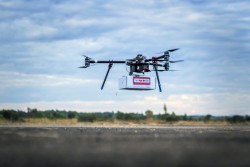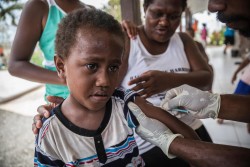

【2017年7月27日 ポート・ビラ(バヌアツ)発】
バヌアツ政府とユニセフ(国連児童基金)は本日、8月に予定しているドローンの試験運転第一フェーズへの参加者を発表しました。
 |
|
© UNICEF/UN070227/Chisiza |
|
ユニセフによるドローン利用実験の様子(2017年6月撮影) ※本文との直接の関係はありません。 |
今回、太平洋地域で初めて、ドローンの通称で知られる遠隔操縦航空機システム(Remotely Piloted Aircraft Systems:RPAS)を利用した、バヌアツの遠隔地のコミュニティに命を守るワクチンを届けるテストを実施し、その能力、効率、効果を検証します。
「バヌアツはその地形、物流の難しさ、高額な費用によって、地域の保健施設に必要不可欠な医療物資を常備することが課題となっています。このテストは、脆弱なコミュニティに保健ケアを提供する上での課題を克服するための選択肢を開拓するという意味で重要なステップになります」とバヌアツ保健省の事務次官George Taleoは述べました。
バヌアツ保健省、公共事業省およびユニセフは、テストの第一フェーズに参加申請した候補者の選考を終え、最終的に6組の参加候補者が決定されました。参加候補者は以下の通りです:Volans-i inc.、Martek Marine Ltd、JAR Aerospace Pty Ltd、Colugo Systems、Finish the Call LLC、Firetail Bormatec JV.
8月に、参加者たちは、米国、英国、イスラエル及びオーストラリアからの自己資金でバヌアツに集まり、それぞれドローンの性能をテストします。
 |
|
© UNICEF/UNI181571/Sokhin |
|
はしかと風疹の予防接種を受ける子ども (2015年3月撮影) |
「ユニセフは、遠隔地のコミュニティへのワクチン提供をより確実にする可能性があるこの素晴らしい取り組みのために、バヌアツ政府と協力できることを嬉しく思っています」とユニセフ東アジア・太平洋地域事務所代表シェルドン・ヤッテは語りました。「私たちは、この段階的に行うテストが、現状では届けることが困難な地域にいかにして医療物資をより信頼できる形で運べるかを学ぶ最初のステップと考えています」
バヌアツ政府の民間航空局長Joseph Nielは、「この第一フェーズは技術的なテストです。ここから得られた結果は今後のテストに必要不可欠な情報となります」と述べました。
このドローンテストの第一フェーズは8月21日から25日に実施されます。参加者は、エフェテ島北部(North Efate)の旧タカラ(Takara)滑走路から、沖合の島々、エマオ (Emao)、ペレ(Pele) ならびに ヌグナ(Nguna) の上空を飛行し、54キロメートル離れたアンディン湾(Undine Bay)上に設置された標的を狙ってパッケージを投下します。その後ドローンはタカラ滑走路に戻り着陸します。
このテストは3つのフェーズによって構成されています。8月には、技術的なテストとして、エフェテの島々の上空を飛行し様々な技術的性能の基準に沿って評価されます。2018年2月と3月には、対象とする島々の保健員に、ワクチンを届ける方法のプロポーザルを提出してもらいます。2018年内には、より長期間、定期的な医療物資の輸送にドローンを利用する試験を実施します。
この取り組みは、バヌアツの保健省および公共事業省が指揮をとり、ユニセフが技術的・資金的支援を行っています。
【関連ページ】
シェアする